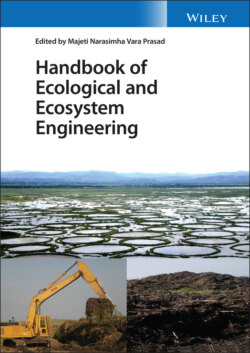Читать книгу Handbook of Ecological and Ecosystem Engineering - Группа авторов - Страница 31
2.3.3 Salinity and Sodicity
ОглавлениеDescription of the marginality factor: The salinization process is focused on arid and semi‐arid regions and depends on the soil texture and relative water and salt content [152, 153]. It consists of changes in the patterns of precipitation, evapotranspiration, and landscape hydrology caused by the presence of chlorides, sulfites, nitrates, and bicarbonates of sodium, calcium, magnesium, and potassium that affect the microbial activity of soils and vegetation zonation and cover [153]. Since natural biological, biochemical, hydrological, and erosional earth cycles can be affected by the salinization process, environmental and agricultural services can also be lost [154].
Revitalization by ecosystem engineering: The species A. donax L. can be classified as “moderately salt‐tolerant” [155]. At 42 dS/m, the giant cane's overall growth is affected, but with zero mortality [155]. Gas exchange of giant reed leaves and their overall tolerance to salt is greater than in many food crops (like corn and rice) and energy crops such as Miscanthus, Populus, and Salix that are indigenous in regions where giant reed is now an invasive species [155]. Although A. donax L. is naturally tolerant, some research has tried to improve this tolerance to salts and select which varieties are best adapted to these stress conditions. Both salinity and water stress affect stomatal closure and eventually decrease the photosynthetic rate of this crop, but that some giant reed ecotypes are more tolerant to salinity than to water stress [156]. Also, the inoculation of arbuscular mycorrhizal fungi (Rhizophagus intraradices and Funneliformis mosseae) in giant reed can improve phosphorous extraction by the roots and the plant's overall tolerance to salinity. The plants' nutritional status has been improved along with the efficiency of nutrient use and response to saline stress conditions [157].
Miscanthus tolerance to saline conditions seems to be lower than that of giant reed. Biomass yields of Miscanthus spp. were reduced by 50% at 10.65 dS/m NaCl [158]. In greenhouse experiments, upland switchgrass showed low tolerance to 5 dS/m (with a reduction of 77% in the aboveground biomass, dry weight), while the lowland ecotype showed higher tolerance (with a reduction of 20% in the aboveground biomass, dry weight) [61].
